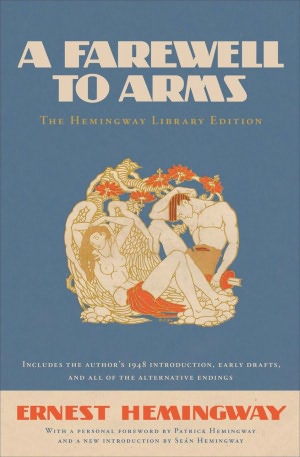 For this Writers on Writers event, Sean Hemingway discusses his grandfather’s work A Farwell to Arms, lauded as the best American novel to emerge from World War I.
For this Writers on Writers event, Sean Hemingway discusses his grandfather’s work A Farwell to Arms, lauded as the best American novel to emerge from World War I.
Written when Ernest Hemingway was thirty years old and lauded as the best American novel to emerge from World War I, A Farewell to Arms is the unforgettable story of an American ambulance driver on the Italian front and his passion for a beautiful English nurse. Set against the looming horrors of the battlefield—weary, demoralized men marching in the rain during the German attack on Caporetto; the profound struggle between loyalty and desertion—this gripping, semiautobiographical work captures the harsh realities of war and the pain of lovers caught in its inexorable sweep.
Ernest Hemingway famously said that he rewrote the ending to A Farewell to Arms thirty-nine times to get the words right. This edition collects all of the alternative endings together for the first time, along with early drafts of other essential passages, offering new insight into Hemingway’s craft and creative process and the evolution of one of the greatest novels of the twentieth century. Featuring Hemingway’s own 1948 introduction to an illustrated reissue of the novel, a personal foreword by the author’s son Patrick Hemingway, and a new introduction by the author’s grandson Seán Hemingway, this edition of A Farewell to Arms is truly a celebration.
Ernest Hemingway
Born in Oak Park, Illinois, in 1899, Ernest Hemingway served as an ambulance driver in the Red Cross during World War I and was severely wounded in Italy. He moved to Paris in 1921 to devote himself to writing and lived among the expatriate community that included Gertrude Stein, F. Scott Fitzgerald, and Ezra Pound. Defined by economy of language and understatement, Hemingway’s terse prose revolutionized American writing. He was awarded the Nobel Prize for Literature in 1954, and his classic novella The Old Man and the Sea won the Pulitzer Prize in 1953. Known for his larger-than-life personality and his passions for bullfighting, fishing and big-game hunting, he died in Ketchum, Idaho, on July 2, 1961.
Biography
Ernest Hemingway (1899-1961), born in Oak Park, Illinois, started his career as a writer in a newspaper office in Kansas City at the age of seventeen. Before the United States entered the First World War, he joined a volunteer ambulance unit in the Italian army. Serving at the front, he was wounded, was decorated by the Italian Government, and spent considerable time in hospitals. After his return to the United States, he became a reporter for Canadian and American newspapers and was soon sent back to Europe to cover such events as the Greek Revolution.
During the twenties, Hemingway became a member of the group of expatriate Americans in Paris, which he described in his first important work, The Sun Also Rises (1926). Equally successful was A Farewell to Arms (1929), the study of an American ambulance officer’s disillusionment in the war and his role as a deserter. Hemingway used his experiences as a reporter during the civil war in Spain as the background for his most ambitious novel, For Whom the Bell Tolls (1940). Among his later works, the most outstanding is the short novel, The Old Man and the Sea (1952), the story of an old fisherman’s journey, his long and lonely struggle with a fish and the sea, and his victory in defeat.
Hemingway — himself a great sportsman — liked to portray soldiers, hunters, bullfighters – tough, at times primitive people whose courage and honesty are set against the brutal ways of modern society, and who in this confrontation lose hope and faith. His straightforward prose, his spare dialogue, and his predilection for understatement are particularly effective in his short stories, some of which are collected in Men Without Women (1927) and The Fifth Column and the First Forty-Nine Stories (1938). Hemingway died in Idaho in 1961.
© The Nobel Foundation 1954.















